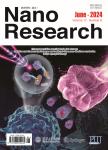Interplay of Adsorbate-Adsorbate and Adsorbate-Substrate Interactions in Self-Assembled Molecular Surface Nanostructures
相互吸附质吸附质和吸附质底物的相互作用在分子表面纳米结构的自组装作者机构:Interdisciplinary Nanoscience CenteriNANOand Department of Physics and AstronomyAarhus UniversityBuilding 1521Ny Munkegade8000 Aarhus CDenmark Division of Synchrotron Radiation ResearchDepartment of PhysicsLund UniversityBox 11822100 LundSweden Shanghai Key Laboratory for Metallic Functional MaterialsKey Laboratory for Advanced Civil Engineering Materials(Ministry of Education)College of Materials Science and EngineeringTongji University1239 Si Ping RoadShanghai 200092China Institute for Storage Ring FacilitiesAarhus UniversityBuilding 1525Ny Munkegade8000 Aarhus CDenmark
出 版 物:《Nano Research》 (纳米研究(英文版))
年 卷 期:2010年第3卷第7期
页 面:459-471页
核心收录:
学科分类:081704[工学-应用化学] 07[理学] 070304[理学-物理化学(含∶化学物理)] 08[工学] 0817[工学-化学工程与技术] 0703[理学-化学]
基 金:J.S.acknowledges funding from the European Commission through a Marie Curie Intra-European Fellowship Funding from the Swedish Research Council(VR)is gratefully acknowledged
主 题:Molecular self-assembly hydrogen bonding scanning tunnelling microscopy X-ray photoelectron spectroscopy
摘 要:The adsorption of 2,6-naphthalenedicarboxylic acid(NDCA)molecules on the Ag(110),Cu(110),and Ag(111)surfaces at room temperature has been studied by means of scanning tunnelling microscopy(STM).Further supporting results were obtained using X-ray photoelectron spectroscopy(XPS)and soft X-ray absorption spectroscopy(XAS).On the Ag(110)support,which had an average terrace width of only 15 nm,the NDCA molecules form extended one-dimensional(1-D)assemblies,which are oriented perpendicular to the step edges and have lengths of several hundred *** shows that the assemblies have a large tolerance to monatomic surface steps on the Ag(110)*** observed behaviour is explained in terms of strong intermolecular hydrogen bonding and a strong surface-mediated directionality,assisted by a sufficient degree of molecular backbone *** contrast,the same kind of step-edge crossing is not observed when the molecules are adsorbed on the isotropic Ag(111)or more reactive Cu(110)*** Ag(111),similar 1-D assemblies are formed to those on Ag(110),but they are oriented along the step *** Cu(110),the carboxylic groups of NDCA are deprotonated and form covalent bonds to the surface,a situation which is also achieved on Ag(110)by annealing to 200°*** results show that the formation of particular self-assembled molecular nanostructures depends significantly on a subtle balance between the adsorbate-adsorbate and adsorbate-substrate interactions and that kinetic factors play an important role.



